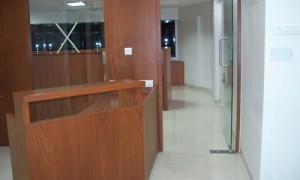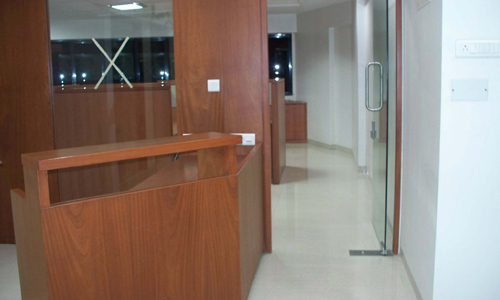 Track2Realty: Total net office space absorption recorded a 25% decline in across top eight cities over last year. According to the annual year end estimations by Cushman & Wakefield the total net absorption for 2013 was recorded at 23 million square feet (msf). Most cities have witnessed a decline in net absorption in the range of 20-40% during the year, except Pune where incremental new space take-up increased by 15% in 2013.
Track2Realty: Total net office space absorption recorded a 25% decline in across top eight cities over last year. According to the annual year end estimations by Cushman & Wakefield the total net absorption for 2013 was recorded at 23 million square feet (msf). Most cities have witnessed a decline in net absorption in the range of 20-40% during the year, except Pune where incremental new space take-up increased by 15% in 2013.
Mumbai registered the highest quantum of net office space absorption at 4.7 msf, followed by Bengaluru with office space absorption of approximately 4.6 msf in the year of 2013. The net absorption recorded decline, mostly on account of companies focusing on relocation, expansion and consolidation in order to rationalize costs as well as create greater value for the company operations within the country.
Although the net absorption recorded a steep decline, the leasing activity was recorded at 35 msf, a marginal decline of 2% compared to last year. Pre-commitments during the year also declined compared to previous year by 12% to 6.0 msf, majority of them noted in Bengaluru, Hyderabad and Mumbai.
There was a corresponding decline in the total supply during the same period which reduced by 14% over the last year and was noted at 34 msf. Vacancy across the office market increased by 0.9 percentage point from 2012 and was 19.4% at the end of 2013. Developers have also adopted a cautious approach towards supply to achieve acceptable occupancy rates in their projects.
Sanjay Dutt, Executive Managing Director, South Asia, Cushman & Wakefield said, “Caution prevailed across corporations due to the slower growth of the Indian economy. Also at the political arena, this has been a year of realignments and retrospect. Given which Indian and global corporate had decided to remain invested but contained their expansion plans. Going forward, with the political dust settling by the mid of next year post general elections, we expect net absorption to start picking up pace. With pricing remaining largely stable, next year will be an occupiers’ market offering better quality office space for competitive pricing. Leasing activities will see an increase both on account of entry of new companies into the country, expansion of existing companies and indeed relocation and consolidation activities that are expected to continue.”
Private equity investments in real-estate have remained healthy in 2013 with large contributions from investments in pre-leased office assets. Investments in office assets have been concentrated in the cities of Bengaluru and Pune. In Bengaluru, investments in office assets were concentrated in the Outer Ring road, which over the past few years has grown due to availability of quality supply at competitive rentals for IT-ITeS companies coupled with the locations enjoying easy connectivity to social infrastructure and proximity to emerging residential catchments. Close to 46% of the overall net-absorption in 2013was concentrated in the Outer Ring Road belt. Large investment funds have also been invested heavily in office assets in Pune, primarily in the micromarkets of Hinjewadi and Kharadi. With the presence of large IT parks offering competitive rentals and the availability of necessary infrastructure to support both residential and office sector growth, Hinjewadi and Kharadi have always had high preference by the IT-ITeS industry.
“Investors have taken a keen interest in office spaces, especially in future high growth locations. Of the total investment in commercial real estate market, majority has been in Outer Ring Road of Bengaluru, which is expected to see majority of office leasing activities. Similar outlook is maintained for the region of Hinjewadi in Pune. These will be markets will remain tight with a balance in office absorption and supply, and will see the highest quantum of leasing activities at competitive pricing in the next 12 – 24 months,” adds Sanjay.
Ahmedabad
The commercial office market in Ahmedabad witnessed an overall net absorption of approximately 566,000 square feet (sf) during 2013 which was lower by 37% compared to previous year mainly due to limited expansions by companies during the year. Grade A net absorption was concentrated in the micro-markets of Prahladnagar (53%) and S.G. Highway (44%).
Average transaction size in the city was in the range of 5,000-7,000 sf. Ahmedabad recorded a decline of 6% in office supply with approximately 1.9 msf getting infused to the inventory. Grade A developments constituted around 96% of the total new supply.
Approximately 4.5 msf of office space is expected to come into supply in 2014. Owing to high supply and subdued absorption levels, overall vacancies increased to 17.7% at the end of 2013 from 11.7% in 2012. Going forward, in year 2014 the overall leasing activity is likely to remain low exerting a downward pressure on rental values.
Bengaluru
Office market of Bengaluru recorded net absorption of around 4.6 msf. The year 2013 was characterized by sizeable relocation and consolidation activities amounting to over 50% of the leasing activity. Given the prevailing market conditions, the occupiers (primarily belonging to IT/ITeS sector) utilized the opportunity to consolidate their operations in order to gain operational efficiency and cost advantages by negotiating long term deals for large spaces at better terms. IT/ITeS sector continued to be the major demand driver accounting for over 60% of the transaction activity followed by Manufacturing (8.5%) and Consulting sectors (7.7%).
Outer Ring Road and Whitefield were the most active commercial markets recording 46% and 30% of the total net absorption respectively. This was mainly due to the availability of quality space options at competitive rentals, proximity of residential catchments and good support infrastructure. Out of total pre-commitments of 2.4 msf in 2013, over 77% were concentrated around the peripheral locations of Outer Ring Road. The occupiers are anticipated to remain cautious during the coming year. Overall absorption, rents and vacancy levels are expected to be at par with 2013 levels.
Chennai
The overall net absorption of office spaces in 2013 decreased by 25% on a y-o-y basis. High quantum of leasing activity in the form of relocations and consolidations by IT companies from Central Business District to Peripheral and Suburban submarkets were the major causes for the decline in net absorption levels, which were recorded at 3.1 msf for the year.
A total of 3.4 msf new office space became available in the market during the year, registering a 27% decline on a yearly basis. In continuation with the trend witnessed last year, all pre-commitments by IT/ITeS companies were in Grade A developments. This was mainly due to the upcoming contiguous spaces in suburban locations at relatively lower that offer scalability of operations in the coming year.
In 2014, nearly 2.2 msf new office supply is expected to be infused in locations of Suburban-Guindy, Suburban-Perungudi Taramani, Peripheral-RGS and CBD. Almost 1.0 msf of this upcoming supply will be dedicated IT/ITeS space, followed by 0.5 msf commercial spaces and the remainder in Special Economic Zones for IT/ITeS.
Hyderabad
The commercial real estate market of Hyderabad witnessed net absorption of approximately 2.36 msf during 2013, nearly 29% lower than the last year due to the cautious approach adopted by companies towards expansion considering the current uncertain political scenario prevailing over the city’s future. The IT-ITeS sector in 2013 accounted for 64% of the leasing activity and continued to be the largest demand driver for office space followed by other sectors like BFSI, Pharmacy, Consulting, Manufacturing and Telecom.
The total office supply for the city for 2013 was approximately 3.9 msf, nearly 32% higher than last year with Grade A contributing to 41% of the pie. The overall city vacancy in the first three quarters remained more or less stable at approximately around 17.5%. However, in Q4 2013 the vacancy level was recorded at 19.8%, witnessing a yearly increase of 5.6 percentage points, due to influx of 2.24 msf of commercial office space in the last quarter of 2013. Many occupiers relocated from Grade B properties in submarkets such as CBD, Off-CBD and Prime suburban to the Grade A and B properties in Madhapur and Gachibowli micro-markets to optimize their real estate costs and for access to better infrastructure and facilities.
The rentals remained stable across all locations due to the moderate demand and supply scenario in 2013. The expected supply for the next 3-6 months is approximately 5.1 msf, out of which 70% is Grade A. Absorption in 2014 is expected to remain moderate due to current political scenario. However, vacancy levels are likely to increase due to the influx of new supply in the market.
Kolkata
In 2013, the net absorption was recorded at approximately 884,000 sf, which is a decline of 26% on annual basis as demand for office space remained subdued due to economic slowdown. While IT/ITeS continued to be the highest contributor with 36% share in total net absorption it was significantly 85% lesser this year compared to couple of years ago. On the other hand the share of BFSI and Telecom sectors in total net absorption increased in 2013. The total supply during the year declined by about 11% over the last year and was noted at 1.9 msf. This was largely owing to the slow pace of business activity and currently high availabilities, especially in the peripheral micro-market of Salt Lake.
Peripheral micro-markets of Salt Lake and Rajarhat continued to have majority share (75%) in the total supply. Also, 60% of the total supply that entered the market during 2013 was of IT/ITeS and SEZ category. The overall vacancy levels steadily increased during the year and were recorded at 24.2% at the end of fourth quarter with Salt Lake market registering highest vacancy level of 34% among all the micro-markets.
The city is expected to witness new supply of around 5 msf next year. The net absorption level, which is expected to remain at similar levels as 2013, will result in a rise in vacancy levels and will put pressure on rentals, especially in peripheral locations of Salt Lake and Rajarhat.
Mumbai
Mumbai witnessed similar levels of supply and net absorption both recorded at 4.7 msf. The city also witnessed the highest net absorption across the eight cities, however there was a decline of 25% compared to the 2012. This was primarily due to subdued expansions by companies in the IT/ITeS and BFSI sectors. Net absorption during the year was concentrated in suburban and peripheral locations of Thane-Belapur Road (25%), Andheri (21%), Malad/Goregaon (20%) and Lower Parel (10%). The city witnessed an overall supply of 4.7 msf in 2013, a substantial decline of 56% compared to 2012 with 88% contribution from Grade A developments.
Supply during the year was concentrated in locations like Malad/Goregaon (30%), Andheri (22%), Thane-Belapur Road (19%) and Central Suburbs (12%). With a decline in supply during the year, overall vacancies at the end of 2013 declined to 18.6% from 19.7% in 2012. Companies from the FMCG, Pharmaceuticals and IT/ITeS sectors have actively relocated and expanded operations in suburban and peripheral locations of Andheri, Malad/Goregaon, Powai and Thane-Belapur road during the year.
Approximately 11.5 msf of supply is estimated in 2014, while the net absorption is expected to remain stable. The supply will be concentrated in Thane-Belapur Road, Goregaon and central suburbs of Kurla, Kanjurmarg and Vikhroli. This is likely to result in increase in vacancies and exert pressure on rentals in select micro-markets of Mumbai.
National Capital Region (NCR)
Net absorption in NCR was noted at 3.5 msf as a number of occupiers in IT/ITeS sector relocated and consolidated operations to achieve cost and operational efficiencies in suburban locations. The city saw new supply of 9.1 msf during 2013 which is 37% higher than the previous year primarily constituted in commercial office projects (63%) followed by 25% in IT Parks and 12% in IT SEZs. The Delhi CBD (Connaught Place) saw the highest increase of 17% in rents over the year followed by suburban locations of Gurgaon and Noida that saw around 7-8% increase.
Gurgaon continued to witness the highest supply followed by Noida and New Delhi. Of the total supply 70% was in Gurgaon with 25% in Noida and 5% in New Delhi. Further, due to steady infusion of supply the vacancy levels across the city increased to 28.5% at the end of the year. The year ahead will witness, approximately 15 msf of new supply in Delhi NCR, of which some is expected to be deferred given the past trends. However with demand expected to be largely subdued further infusion of supply is likely to increase the overall vacancy levels.
Pune
The commercial real estate market of Pune witnessed total net absorption of 3.5 msf recording an overall increase of 15% y-o-y, nearly 78% of which was Grade A. This significant rise in net absorption of Grade A spaces is attributed to the growing preference amongst occupiers for quality developments. The city witnessed a total supply of 3.5 msf , of which 3.2 msf was contributed by Grade A developments.
The total supply increased by nearly 66% compared to 2012 with majority spread across locations of Viman Nagar, Kharadi, Hinjewadi, Airport Road and Kalyani Nagar. This led to a rise in vacancy levels from 21% in 2012 to 23.5% in 2013. Approximately 5.7 msf of office space is expected to come into supply in 2014, of which Grade A spaces are expected to contribute nearly 65% Majority of this supply will be concentrated in areas like Airport Road, Yerwada and in the suburban and peripheral areas of Kharadi, Viman Nagar, Nagar Road, Hinjewadi, Baner, and Balewadi. This inflow of supply is expected to drive up the vacancies across submarkets as transaction activity is expected to remain stable.





